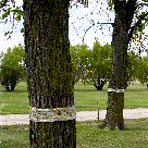Tree Banding
What is tree banding?

Tree banding keeps the wingless adult female fall and spring cankerworms from laying their eggs in the crown of the tree. The bands are made from insulation and plastic and are covered in a sticky substance called Tree Tanglefoot. The adult cankerworm must climb the tree to lay eggs. They get stuck in the Tanglefoot when they cross the band.
Make sure to keep your band clean and free of debris as adult female cankerworms will crawl over the band if enough debris is present.
Why tree band?
If you band your trees before the adult, wingless female cankerworm moths lay their eggs, you will keep the larval cankerworms from eating your trees the following spring.
When should I band my tree?
To control the spring cankerworm, you must have your bands on the trees by March 15 and/or reapply on existing bands originally setup in September to control the fall cankerworm.
To control the fall cankerworm, you must have your bands on the trees by the end of September or before the first hard frost making sure to keep bands on over the winter months and then reapplying in the spring to control the spring cankerworm.
Can I leave the tree bands up all year long?
You must remove bands by early June. Otherwise the bark can rot when the insulation gets wet. Bands should again be put up in September and can remain all winter.
How do I tree band?
To band your tree using foil-faced insulation:
- Cut a 15 centimetre wide band of foil-faced insulation long enough to wrap around the tree trunk.
- Place the insulation side on the bark so that the foil is on the outside.
- About 1.5 metres from the ground, tightly staple the band to the tree trunk. Make sure you fill in the bark's cracks and crevices.
- Spread a layer of Tree Tanglefoot on the band.
- Encourage you neighbours to band together to keep your neighbourhood green.
To help control cankerworms now is the time to make sure your bands are up. See the above link or visit our cankerworm page to learn more about their biology.


